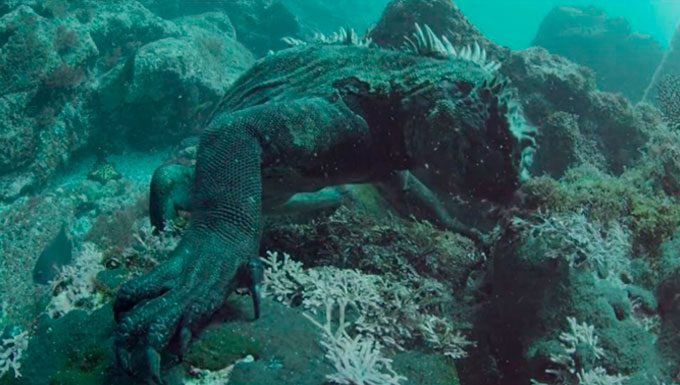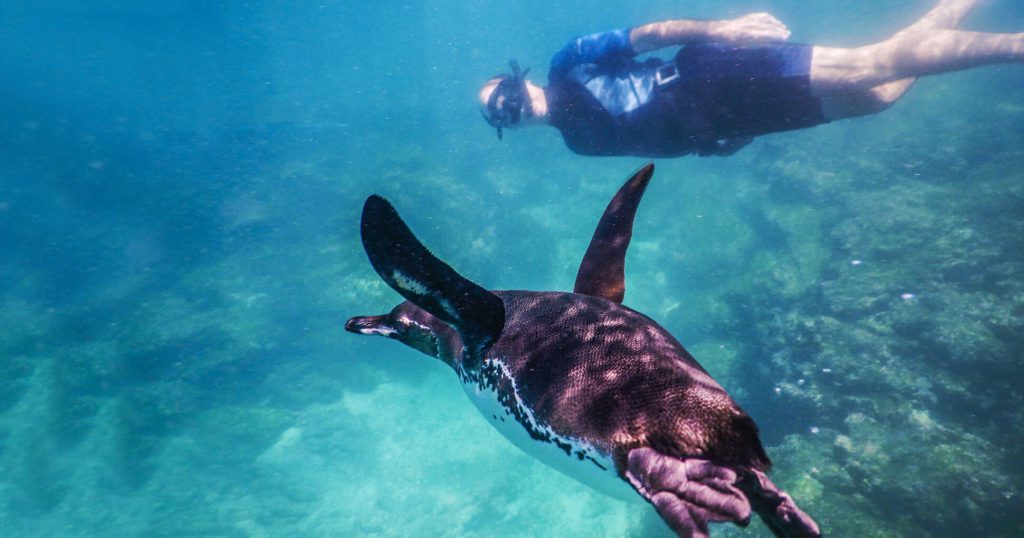Snorkeling in the Galapagos is the best way to see some of the incredible marine life surrounding the islands. You may miss a whole wonderland of lifeforms if you stay on the ground, but it can be learned in a few hours, even by youngsters. Remember that the waters surrounding the Galapagos Islands are both UNESCO World Heritage Sites and the largest marine protected region in the Americas, having been designated as Marine Reserves.
TALK TO A DESTINATION EXPERT

Diego Zapata

Rosa Mena

Sandy Lara

Diego Zapata

Rosa Mena

Sandy Lara
YOUR TRIP’S HIGHLIGHT MAY BE SNORKELING
Live the adventure of a lifetime snorkeling with the most iconic creatures of the Galapagos Islands!
One of the finest ways to witness marine life in its native habitat is snorkeling. Snorkeling’s primary benefit over scuba diving is that it doesn’t require certification or high-tech equipment. Fins, a floating vest, a mask, and a snorkel are all you need. When visiting the islands in the dry season (June to November), when the water is colder than tropical norms, you should pack a wetsuit. However, wetsuits are always available onboard expedition ships. Children’s wetsuits and snorkeling equipment are also available.
Snorkel gear can be rented on an expedition cruise to the Galapagos Islands. Your naturalist guide will assist you in identifying and observing the variety of marine species you come across.
Sea Turtles
Despite their size, sea turtles are incredibly skilled swimmers and travelers. They are marine reptiles that peacefully monitor the ocean. They appear unaffected by the presence of divers and snorkelers and swim with ease. Punta Vicente Roca on Isabela Island is one of the best locations for swimming with sea turtles. The water appears dark because of the soft, black sand, and the adjacent steep drop-offs make them visible in the deep blue sea. Champion Islet, located on Floreana Island, is another fantastic spot. Sea turtles can be seen swimming and resting in shallow areas. These serene and self-assured creatures drift with the ocean’s currents, pursuing jellyfish and drifting tunicates in the open sea. Finding sea turtles in the ocean is fun for everyone, and their calm, easygoing attitude is infectious.
Marine Iguanas
The Galapagos Islands are the only place to find these fantastic lizards. They have been highly adapted to the maritime environment throughout the millennia by learning to feed on algae and seaweed. They have a large, flat tail that helps them move through the water quickly, and they are excellent swimmers. Likewise, they can also be seen sleeping on the rocks along the shore, and as part of their ongoing desalination process, they occasionally sneeze to clear the salt buildup in their noses. Because of this puff of ground salt, the early explorers mistook the iguanas for dragons. Underwater pastures in Punta Espinoza, Fernandina Island, and Rabida Island are beautiful places to see marine iguanas and sea turtles graze.

Snorkeling in Galapagos, Tropical Fishes and More
On Floreana Island, Champion Islet is a dilapidated volcanic cone. It provides an exhilarating ride for snorkelers, as the currents carry you around one side with minimal swimming effort. During your journey around the crown, you will witness a wide diversity of marine species that call these protected waters home. The aquatic life you will see includes rays, reef sharks, parrotfish, angelfish, wrasses, groupers, snappers, and amberjacks. This place is extraordinary since it has a peculiar mix of fish species from both the tropics and the subtropics—basically, a natural aquarium. You might be accompanied on your crazy journey by sea lions and turtles. This is regarded by many as one of the best places to do scuba diving and snorkeling.
SEEMLY AS A MAMMAL, BUT HOLD ON… It’s a Galapagos Penguin!
It’s an incredible experience to snorkel in the Galapagos with the elegant little penguins. Chasing schools of little fish, they zigzag across the water at great speeds. You can snorkel with penguins at Chinese Hat Islet and Bartolome Island and sea lions, green turtles, and reef sharks. When their mother searches for food, the sea lion pups stay safe and secure in a remote cove. In an attempt to dazzle snorkelers, sea lions frequently blow bubbles at them and do amazing underwater tricks.
Snorkeling is a great way to get a close-up of the Galapagos Islands’ iconic marine life.
Sea Lions
A distinct marine habitat can be found in tranquil areas like Gardner Bay on Española Island or Rabida Island. Here’s where snorkelers can witness some of the most impressive sea lion displays. Though the sea lions will take center stage, you may expect to observe some interesting marine species here. Snorkelers enjoy being teased and impressed by them, and they reciprocate.
Hammerhead Sharks
While snorkeling in the Galapagos, Prince Phillip’s Steps on Genovesa (Tower) Island is the best area to spot hammerhead sharks, though there’s no assurance the sharks will be there each time we enter the water. Sharks are creatures of constant movement. Therefore, our chances of seeing them during our lifetime depend primarily on luck. Shark sightings during snorkeling are rare, but if you ask your guide, you can find them by doing more in-depth searching. Darwin Bay is a submerged caldera on this flat, pancake-shaped island—possibly just a massive pit crater. Large fish and an array of vibrant tropical fish can be seen here. Owing to its northern location, warm-water fish species such as convict tangs, wrasses, and boxfish can be observed.
One of the most incredible spots in the world to dive or snorkel is the Galapagos Islands. The diversity and quantity of marine life are astounding, and many creatures invite you to enter their world. Additionally, it is the real hidden secret of the islands since the media typically focuses more on the archipelago’s terrestrial species and less on its marine counterpart. However, putting on a mask ushers in a whole new adventure, and this is precisely how the spirit of exploration thrives on the Galapagos Islands.
Going on an expedition cruise is one of the finest ways to enjoy a fantastic time snorkeling in the Galapagos. There are a lot of benefits, such as visiting other islands at night to maximize your daylight hours on land or in the water. The cruise captain and crew adhere to strict environmental protocols, so you can be confident that your journey is environmentally friendly and that you will have a professional guide. Here’s a major surprise: excursion boats with glass-bottom boats will emphasize knowledge and viewing of the marine environment for non-snorkelers. So don’t worry if you don’t want to snorkel.

Javier Garcia

Eduardo Silva

Carolina Escobar
START PLANNING YOUR TRIP

Javier Garcia

Eduardo Silva

Carolina Escobar
Get in touch for more
CONTACT US



